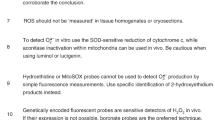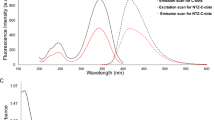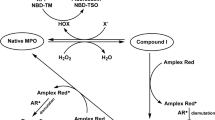Abstract
The spectrophotometric/microplate reader assay method for glutathione (GSH) involves oxidation of GSH by the sulfhydryl reagent 5,5′-dithio-bis(2-nitrobenzoic acid) (DTNB) to form the yellow derivative 5′-thio-2-nitrobenzoic acid (TNB), measurable at 412 nm. The glutathione disulfide (GSSG) formed can be recycled to GSH by glutathione reductase in the presence of NADPH. The assay is composed of two parts: the preparation of cell cytosolic/tissue extracts and the detection of total glutathione (GSH and GSSG). The method is simple, convenient, sensitive and accurate. The lowest detection for GSH and GSSG is 0.103 nM in a 96-well plate. This method is rapid and the whole procedure takes no longer than 15 min including reagent preparation. The method can assay GSH in whole blood, plasma, serum, lung lavage fluid, cerebrospinal fluid, urine, tissues and cell extracts and can be extended for drug discovery/pharmacology and toxicology protocols to study the effects of drugs and toxic compounds on glutathione metabolism.
This is a preview of subscription content, access via your institution
Access options
Subscribe to this journal
Receive 12 print issues and online access
$259.00 per year
only $21.58 per issue
Buy this article
- Purchase on SpringerLink
- Instant access to full article PDF
Prices may be subject to local taxes which are calculated during checkout

Similar content being viewed by others
References
Halliwell, B. Antioxidants in human health and disease. Annu. Rev. Nutr. 16, 33–50 (1996).
Rossi, R. et al. Blood glutathione disulfide: in vivo factor or in vitro artifact? Clin. Chem. 48, 5742–5753 (2002).
Tietze, F. Enzymic method for quantitative determination of nanogram amounts of total and oxidized glutathione: applications to mammalian blood and other tissues. Anal. Biochem. 27, 502–522 (1969).
Brigelius, R., Muckel, C., Akerboom, T.P. & Sies, H. Identification and quantitation of glutathione in hepatic protein mixed disulfides and its relationship to glutathione disulfide. Biochem. Pharmacol. 32, 2529–2534 (1983).
Guntherberg, H. & Rost, J. The true oxidized glutathione content of red blood cells obtained by new enzymic and paper chromatographic methods. Anal. Biochem. 15, 205–210 (1966).
Reed, D.J. et al. High-performance liquid chromatography analysis of nanomole levels of glutathione, glutathione disulfide, and related thiols and disulfides. Anal. Biochem. 106, 55–62 (1980).
Newton, G.L., Dorian, R. & Fahey, R.C. Analysis of biological thiols: derivatization with monobromobimane and separation by reverse phase high-performance liquid chromatography. Anal. Biochem. 114, 383–387 (1981).
Griffith, O.W. Determination of glutathione and glutathione disulfide using glutathione reductase and 2-vinylpyridine. Anal. Biochem. 106, 207–212 (1980).
Rahman, I., Li, X.Y., Donaldson, K., Harrison, D.J. & MacNee, W. Glutathione homeostasis in alveolar epithelial cells in vitro and lung in vivo under oxidative stress. Am. J. Physiol. 269, L285–L292 (1995).
Rahman, I., Mulier, B., Gilmour, P.S., Jeffery, P.K. & MacNee, W. Oxidant-induced lung epithelial cell tolerance: the role of intracellular glutathione and NF-κB. Biochem. Pharmacol. 62, 787–794 (2001).
Roberts, J.C. & Francetic, D.J. The importance of sample preparation and storage in glutathione analysis. Anal. Biochem. 211, 183–187 (1993).
Vandeputte, C., Guizon, I., Genestie-Denis, I., Vannier, B. & Lorenzon, G. A microtiter plate assay for total glutathione and glutathione disulfide contents in cultured/isolated cells: performance study of a new miniaturized protocol. Cell Biol. Toxicol. 10, 415–421 (1994).
Chasseaud, L.F. The role of glutathione and glutathione-S-transferase in the metabolism of chemical carcinogens and other electrophilic compounds. Adv. Cancer Res. 19, 175–274 (1979).
Rahman, I., Bel, A., Mulier, B., Donaldson, K. & MacNee, W. Differential effects of oxidants and dexamethasone on γ-glutamylcysteine synthetase and γ-glutamyl transpeptidase in alveolar epithelial cells. Am. J. Physiol. 275, L80–L86 (1998).
Kode, A., Yang, S.R. & Rahman, I. Differential effects of cigarette smoke on oxidative stress and proinflammatory cytokine release in primary human airway epithelial cells and in a variety of transformed alveolar epithelial cells. 7, 131 (2006).
Galloway, D.C., Blacke, D.G., Shepherd, A.G. & McLellan, L.I. Regulation of human γ-glutamylcysteine synthetase: co-ordinate induction of the catalytic and regulatory subunits in HepG2 cells, Biochem. J. 328, 99–104 (1997).
Shi, M.M. Iwamoto, T. & Forman, H.J. γ-Glutamylcysteine synthetase and GSH increase in quinone-induced oxidative stress in BPAEC. Am. J. Physiol. 267, L414–L421 (1994).
Moellering, D. et al. The induction of GSH synthesis by nanomolar concentrations of NO in endothelial cells: a role of γ-glutamylcysteine synthetase and γ-glutamyltranspeptidase, FEBS Lett. 448, 292–296 (1999).
Shi, M.M., Kugelman, A., Iwamoto, T., Tian, L. & Forman, H.J. Quinone-induced oxidative stress elevates glutathione and induces γ-glutamylcysteine synthetase activity in rat lung epithelial L2 cells. J. Biol. Chem. 269, 26512–26517 (1994).
Kokura, S., Wolf, R.E., Yoshikawa, T., Granger, D.N. & Aw, T.W. Molecular mechanisms of neutrophil-endothelial cell adhesion induced by redox imbalance. Circ. Res. 84, 516–524 (1999).
Yang, S.R. et al. Cigarette smoke induces proinflammatory cytokine release by activation of NF-κB and posttranslational modifications of histone deacetylase in macrophages. Am. J. Physiol. 291, L46–L57 (2006).
Morrison, D., Rahman, I., Lannan, S. & MacNee, W. Epithelial permeability, inflammation and oxidant status in the airspaces of chronic smokers. Am. J. Respir. Crit. Care Med. 159, 1–8 (1999).
Cantin, A.M., North, S.L., Hubbard, R.C. & Crystal, R.G. Normal alveolar epithelial lining fluid contains high levels of glutathione. Am. J. Physiol. 63, 152–157 (1987).
Author information
Authors and Affiliations
Corresponding author
Ethics declarations
Competing interests
The authors declare no competing financial interests.
Rights and permissions
About this article
Cite this article
Rahman, I., Kode, A. & Biswas, S. Assay for quantitative determination of glutathione and glutathione disulfide levels using enzymatic recycling method. Nat Protoc 1, 3159–3165 (2006). https://doi.org/10.1038/nprot.2006.378
Published:
Issue Date:
DOI: https://doi.org/10.1038/nprot.2006.378
This article is cited by
-
Oxidative stress promotes cytotoxicity in human cancer cell lines exposed to Escallonia spp. extracts
BMC Complementary Medicine and Therapies (2024)
-
Exogenous Epigallocatechin-3-Gallate Alleviates Pesticide Phytotoxicity and Reduces Pesticide Residues by Stimulating Antioxidant Defense and Detoxification Pathways in Melon
Journal of Plant Growth Regulation (2024)
-
Mild drought priming-induced salicylic acid involves in subsequent drought tolerance by modulating glutathione redox in antagonism with abscisic acid in Brassica napus
Plant Growth Regulation (2024)
-
Rutin-loaded chitosan nanoparticles alleviated Freund’s adjuvant induced rheumatoid arthritis via modulating oxidative stress and inflammatory parameters in Wistar rats
Naunyn-Schmiedeberg's Archives of Pharmacology (2024)
-
Grape seed extract prevents chlorpyrifos-induced toxicity in rat liver through the modulation of phase I detoxification pathway
Environmental Science and Pollution Research (2024)



